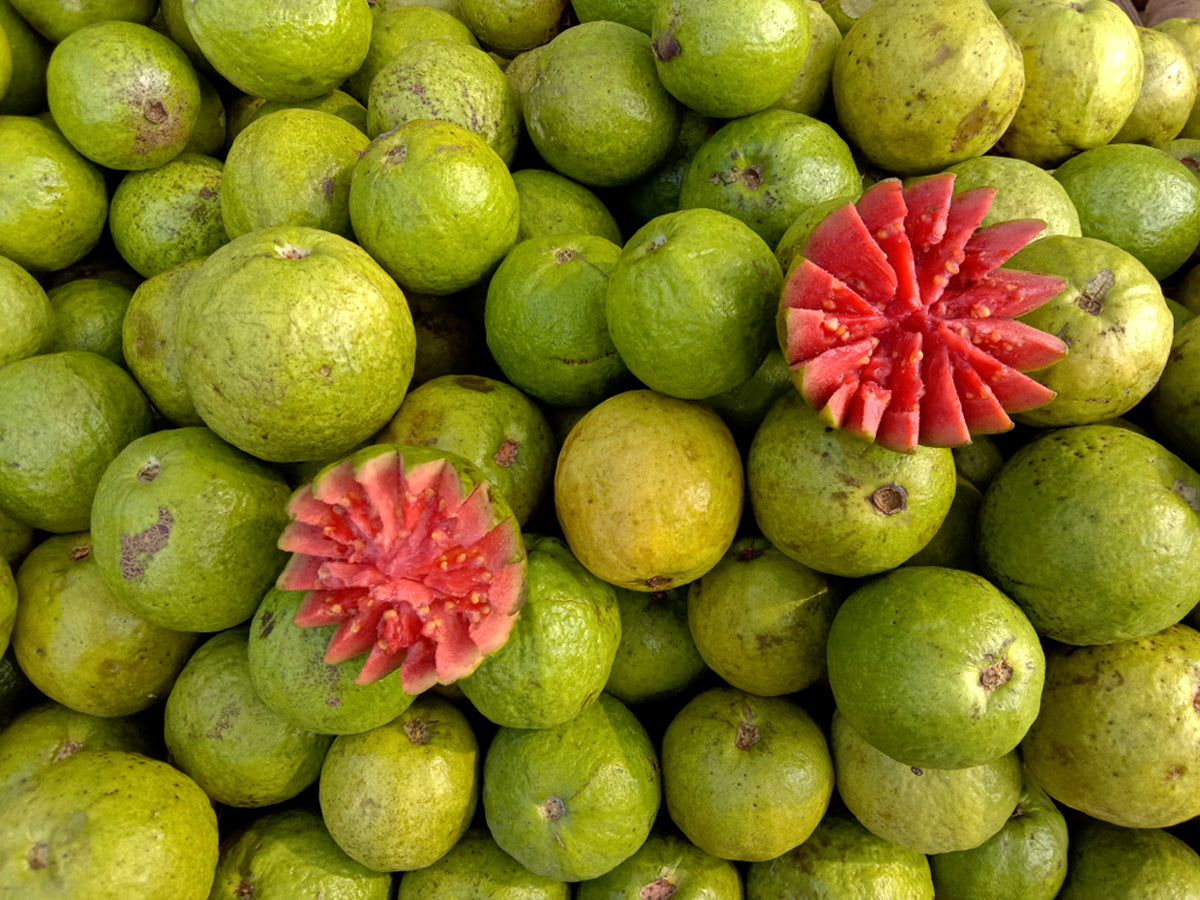How to Grow
Red Guava: A Complete Guide On Growing Techniques, Benefits, And Care Tips
There is no better place than Allahabad when we talk about guava in India. Round in shape and smooth of skin, they are available in small and large varieties.
Guava is a tropical fruit cultivated and consumed in tropical and subtropical regions. Did you know that it is one of the most consumed fruits in India, along with banana, mango, orange, and papaya?
Pyaara in Bengali, peru in Marathi, and most commonly referred to as amrood, the fruit is a favourite. From heart health to weight loss, it brings several benefits.
Red guavas are known to be the juiciest, and their botanical name is psidium guajava. The best part is it is easy to grow and requires simple tools and techniques.
We will focus on the following in this blog -
- Interesting facts about the red guava
- How to grow red guava at home
- Benefits of the red guava
- How to take care of the guava fruit trees
So, let's start!
Interesting Facts About the Red Guava
- The red guava belongs to the family of myrtaceae. It first originated from the tropical American region and, with time, spread around the globe.
- The fruit is prominent in tropical regions, especially India, South America, and Indonesia.
- The red guava plant or small tree has a stemmed trunk and serrated leaves on a short canopy. They bloom with white flowers that eventually produce pear-shaped fruits.
- Trees of this evergreen tropical fruit can touch a height of 20-30 ft. They also have thick stems and form multiple branches as they grow.
- It is high in vitamins C & A, riboflavin, and thiamine. It contains four times more vitamin C than any other citrus fruit.
- The red guava is oval and has a yellowish-green skin with edible seeds.
- The plant gets pollinated by bees.
How To Grow Red Guava at Home
Growing the red guava can be fun, but you must remember that it can be a slow process initially. But once it crosses the young phase, it hits a growth spurt.
Growing Red Guava From Seeds
You can grow this delicious fruit in several ways. It can grow by seed, grafting, and air layering. When it comes to commercial cultivation, most guava plants are grafted to a rootstock that helps them thrive.
- Let the seed sit in water for two weeks. Not only will it increase the chances of germination, but it will also reduce the time. You can also choose to boil the seeds for five minutes.
- Plant it in a pot with a soilless starting mix. Use only a tiny amount of seed starter mix to cover the soil.
- Put the pot in a warm region and maintain its moisture by misting the top soil whenever the surface looks dry. The germination process will take between 2-8 weeks.
- Once the young plant is vigorous, transplant the same into an adult pot.
- Young red guava plants are slow to grow initially, so you should be patient.
Propagate Using Cutting
- You can also propagate guava with softwood cuttings.
- Start by cutting around 4 inches of a young and flexible stem and ensure to remove all leaves barring the top two.
- Now dip the cut side into the rooting hormone and plant it in a potting mix.
- Cover your pot with a clear plastic while popping it up so it stays above the leaves.
- Now plate the pot in a warm location. You will start noticing new growth in two to three weeks, meaning the roots begin to form.
- Next, remove the plastic and regularly water the soil so the cutting can grow further.
- Once the young plant outgrows the pot, transplant it into a large container.
- Guava red plants prosper the best when you grow them in any warm location but not scorching. Thus, you have to find a suitable place for your plant so that it removes ample sun and shade.
Potting & Repotting
It is an essential step during the red guava plant growth. When your seed or cutting starts growing, with time, the young guava will start getting more prominent for a small pot. And this is when you have to transfer it to a larger pot.
Therefore, it is advisable to transfer your young guava every spring. You can prune your plant and keep it smaller during early summer to enhance its chances of bearing fruit.
Air Layering
As the guava tree grows, it will have low branches bent down and start touching the soil. Usually, about 12 cm of the branch will be rooted. You can begin to keep the ground moist to induce root formation.
Benefits Of Red Guava
The red guava benefits are high; thus, it is a great fruit to grow and consume. Some expected benefits of the red guava tree are:
- The guava leaves can be used for making herbal tea, and the leaf extracts as a supplement source.
- The red guava fruit can help in improving the blood sugar control level.
- The main red guava fruit benefits are that it helps heart health in many ways and contains potassium and soluble fibre that helps the body.
- Many studies show that red guava leaf extract has an anti-cancer effect. Because of the high antioxidants, it can fight against damaging cells.
- It has a high amount of vitamin C and antioxidants that help remove toxins from your body. Thus, it can also boost your immunity and reduce the risk of illness and infections.
- The red guava leaf extract can also help reduce women’s pain during menstrual cramps.
- The tree is known to provide beautiful foliage, shade, and flowers. In addition, it doesn’t shed leaves during winter and thus makes for a great attraction.
- Guava fruit can help your digestive system by propagating healthier bowel movements and preventing constipation.
- The red guava is excellent for your skin as the vitamins and antioxidants can work wonders.
How To Take Care of The Guava Fruit Trees?
Growing and maintaining a guava fruit tree is simple and easy. However, you have to keep some basic things in mind about the environment where it is growing, along with regular maintenance, and it will work wonders.
Soil
- The guava plant grows best in a rich potting mix. You can also use a mixture of peat soil and perlite for the plant.
- Ensure that the soil has good drainage and no water accumulation at the bottom, as it can destroy the roots and the soil.
- It is one of the plants that can prosper in different soil types.
- But a well-drained soil with good organic matter and a pH between 5-7 will be ideal.
Sunlight
These trees need full sun for the best growth. Keep the pot or the container in a sunny area. If growing the guava plant in a tropical region, move the container to the shade during the afternoon. You must ensure that the plant receives at least six hours of sunlight daily.
Location
- Red guava trees prosper in a warm and humid climate.
- It is a tropical plant that can quickly adapt to different temperatures except for freezing temperatures.
- Please choose a location that provides a minimum of six hours of sunlight and shade later in the afternoon.
- You can plant them in balconies, front yards, terrace gardens, or backyards.
Fertiliser
- The guava tree is a heavy feeder; thus, you should feed it every month when it is young and change it to twice as they grow.
- Use a fertiliser that has a high content of phosphorous, potash, nitrogen, and magnesium to get the best yield.
- It is recommended to use a 6:6:6:2 amount of N:P:K: Mg to feed the plant.
- Spraying urea regularly just before the blooming season can also help produce better fruit.
Water
- Guava plant prefers good watering at regular intervals. Moreover, allowing the soil to dry between those watering intervals would be best.
- When in the growing season, you can water once daily; during winter, you can water the plant once a week.
- Ensure to only water the base and not sprinkle it on the foliage, which can result in fungal growth.
- These plants thrive when the feed is rainwater.
Temperature
While the guava plants are temperature resistant, the ideal temperature for germination is between 20 and 30 C. Freezing temperatures can harm the plant.
Pruning
- Pruning is compulsory for guava trees as it keeps them compact.
- You can keep the tree in the desired size and shape so that it develops a strong core and is healthy with the help of pruning.
- Make sure you prune dead or diseased branches often. Also, prune the crossing branches that can block the sun to the root.
- It is best to prune the guava tree after harvesting and before the growing season.
Mulching
Mulching is not necessary for guava plants but has some benefits. It can help preserve the moisture in the soil and protect the roots of the plant. However, ensure to mulch far away from the stem, as it can result in fungal infections.
Conclusion
Growing red guava is easy with the above techniques. Moreover, the foliage and the fruit that blooms on it are also stunning. You can start by growing them on your balconies or terrace; they will blossom with minimum care. So what are you waiting for? Grab your tools and plant the guava seeds today!
FAQs
Red guava vs white guava, which is better?
Red guava has higher water content and less starch and sugar. It also has fewer seeds but is high in antioxidants. In contrast, white guava has a higher content of vitamin C.
Do red guava trees lose leaves with time?
No, the guava trees do not lose their leaves even during winter. But you have to take proper care, like watering and pruning, to maintain its health.
Why is my tree turning yellow?
Guava trees can turn yellow as it is a way to show stress or when the weather is extreme. It might also be a symptom of nematodes.
Why are the leaves turning red or purple?
The leaves can turn red or purple when not getting the proper nutrients. It is prominent when it is grown in alkaline soil.
How to increase the fruit size?
Spraying your plant with boric acid, zinc sulfate, and copper sulfate can help increase the yield and the size.



